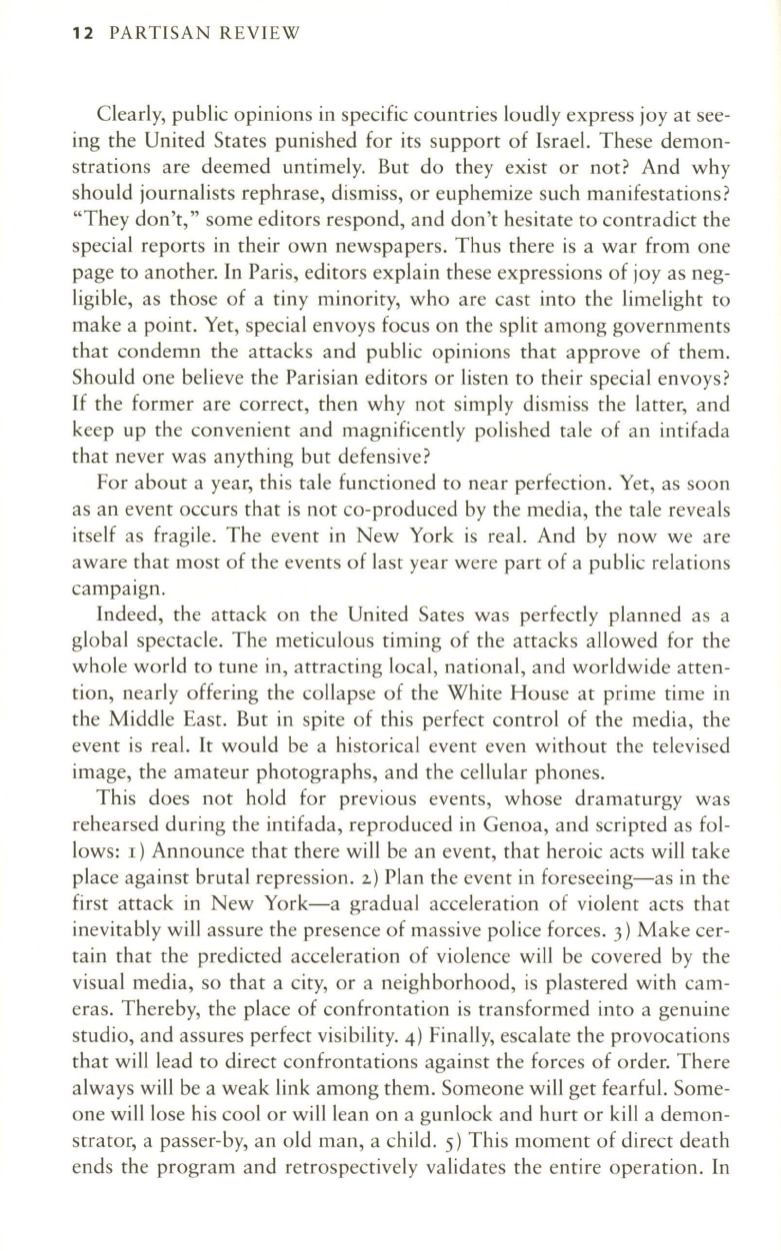
12
PARTISAN REVIEW
Clearly, public opinions in specific countries loudly express joy at see–
ing the United States punished for its support of Israel. These demon–
strations are deemed untimely. But do they exist or not? And why
should journalists rephrase, dismiss, or euphemize such manifestations?
"They don't," some editors respond, and don't hesitate to contradict the
special reports in their own newspapers. Thus there is a war from one
page to another. In Paris, editors explain these expressions of joy as neg–
ligible, as those of a tiny minority, who are cast into the limelight to
make a point. Yet, special envoys focus on the split among governments
that condemn the attacks and public opinions that approve of them.
Should one believe the Parisian editors or listen to their special envoys?
If
the former are correct, then why not simply dismiss the latter, and
keep up the convenient and magnificently polished tale of an intifada
that never was anything but defensive?
For about a year, this tale functioned to near perfection. Yet, as soon
as an event occurs that is not co-produced by the media, the tale reveals
itself as fragile . The event in New York is real. And by now we are
aware that most of the events of last year were part of a public relations
campaIgn.
Indeed, the attack on the United Sates was perfectly planned as a
global spectacle. The meticulous timing of the attacks allowed for the
whole world to tune in, attracting local, national, and worldwide atten–
tion, nearly offering the collapse of the White House at prime time in
the Middle East. But in spite of this perfect control of the media, the
event is real.
It
would be a historical event even without the televised
image, the amateur photographs, and the cellular phones.
This does not hold for previous events, whose dramaturgy was
rehearsed during the intifada, reproduced in Genoa, and scripted as fol–
lows: I) Announce that there will be an event, that heroic acts will take
place against brutal repression.
2)
Plan the event in foreseeing-as in the
first attack in New York-a gradual acceleration of violent acts that
inevitably will assure the presence of massive police forces. 3) Make cer–
tain that the predicted acceleration of violence will be covered by the
visual media, so that a city, or a neighborhood, is plastered with cam–
eras. Thereby, the place of confrontation is transformed into a genuine
studio, and assures perfect visibility. 4) Finally, escalate the provocations
that will lead to direct confrontations against the forces of order. There
always will be a weak link among them. Someone will get fearful. Some–
one will lose his cool or will lean on a gunlock and hurt or kill a demon–
strator, a passer-by, an old man, a child. 5) This moment of direct death
ends the program and retrospectively validates the entire operation . In


